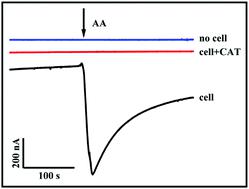当前位置:
X-MOL 学术
›
J. Mater. Chem. B
›
论文详情
Our official English website, www.x-mol.net, welcomes your
feedback! (Note: you will need to create a separate account there.)
A non-enzymatic electrochemical biosensor based on Au@PBA(Ni-Fe):MoS2 nanocubes for stable and sensitive detection of hydrogen peroxide released from living cells.
Journal of Materials Chemistry B ( IF 6.1 ) Pub Date : 2019-11-14 , DOI: 10.1039/c9tb02059d Wang Zhang 1 , Chao Wang , Lihao Guan , Meihong Peng , Kai Li , Yuqing Lin
Journal of Materials Chemistry B ( IF 6.1 ) Pub Date : 2019-11-14 , DOI: 10.1039/c9tb02059d Wang Zhang 1 , Chao Wang , Lihao Guan , Meihong Peng , Kai Li , Yuqing Lin
Affiliation

|
Hydrogen peroxide (H2O2) is the main product of enzymatic reactions and plays an important role in biological processes. The detection of H2O2 inside organisms or cells is critical. Here, we report a nickel–iron Prussian blue analogue nanocube doped with molybdenum disulfide and Au nanoparticles (Au@PBA(Ni–Fe):MoS2) as an electrochemical sensing material for the stable detection of H2O2 in neutral solutions for a long time. First, the Prussian blue analogue (PBA(Ni–Fe)) is synthesized by a simple charge-assembly technology, and then etched into PBA(Ni–Fe):MoS2 hollow nanocubes by a high-temperature hydrothermal reaction. Finally, Au nanoparticles are reduced inside the PBA(Ni–Fe):MoS2in situ to generate Au@PBA(Ni–Fe):MoS2 nanocubes. Ni-doping enhances the nanocube's stability in neutral solutions; as a result, the sensor can maintain a stable current response towards H2O2 reduction for more than 1 h. The sensing material can meet the needs of a long-time test. The introduction of Au enhances the electron transfer efficiency, which endows the sensor with good reduction ability for H2O2 at 0 V over a wide linear range (0.5–200 μM and 210–3000 μM) and with a low detection limit (0.23 μM (S/N = 3)), which fulfills the requirements for the detection of H2O2 in a biological system. The sensor can sense H2O2 released from cells stimulated by ascorbic acid. Au@PBA(Ni–Fe):MoS2 provides good guidance for the future development of efficient biosensors to be applied in cell biology.
中文翻译:

基于Au @ PBA(Ni-Fe):MoS2纳米立方体的非酶电化学生物传感器,用于稳定,灵敏地检测从活细胞释放的过氧化氢。
过氧化氢(H 2 O 2)是酶促反应的主要产物,在生物过程中起着重要作用。检测生物或细胞内部的H 2 O 2至关重要。在这里,我们报告了一种镍铁普鲁士蓝类似物纳米立方体,其中掺杂有二硫化钼和Au纳米颗粒(Au @ PBA(Ni–Fe):MoS 2)作为电化学传感材料,用于稳定检测中性溶液中的H 2 O 2很长时间。首先,通过简单的电荷组装技术合成普鲁士蓝类似物(PBA(Ni–Fe)),然后将其蚀刻成PBA(Ni–Fe):MoS 2中空纳米立方体通过高温水热反应。最后,Au纳米颗粒在PBA(Ni-Fe):MoS 2内部原位还原,生成Au @ PBA(Ni-Fe):MoS 2纳米立方体。镍掺杂增强了纳米立方体在中性溶液中的稳定性;结果,该传感器可以保持对H 2 O 2还原的稳定电流响应超过1小时。传感材料可以满足长期测试的需求。Au的引入提高了电子转移效率,这赋予了传感器对H 2 O 2的良好还原能力。在0 V的线性范围(0.5–200μM和210–3000μM)和低检测限(0.23μM(S / N = 3))范围内,满足了H 2 O 2的检测要求。生物系统。该传感器可以感应从抗坏血酸刺激的细胞释放的H 2 O 2。Au @ PBA(Ni-Fe):MoS 2为细胞生物学中高效生物传感器的未来发展提供了良好的指导。
更新日期:2019-11-14
中文翻译:

基于Au @ PBA(Ni-Fe):MoS2纳米立方体的非酶电化学生物传感器,用于稳定,灵敏地检测从活细胞释放的过氧化氢。
过氧化氢(H 2 O 2)是酶促反应的主要产物,在生物过程中起着重要作用。检测生物或细胞内部的H 2 O 2至关重要。在这里,我们报告了一种镍铁普鲁士蓝类似物纳米立方体,其中掺杂有二硫化钼和Au纳米颗粒(Au @ PBA(Ni–Fe):MoS 2)作为电化学传感材料,用于稳定检测中性溶液中的H 2 O 2很长时间。首先,通过简单的电荷组装技术合成普鲁士蓝类似物(PBA(Ni–Fe)),然后将其蚀刻成PBA(Ni–Fe):MoS 2中空纳米立方体通过高温水热反应。最后,Au纳米颗粒在PBA(Ni-Fe):MoS 2内部原位还原,生成Au @ PBA(Ni-Fe):MoS 2纳米立方体。镍掺杂增强了纳米立方体在中性溶液中的稳定性;结果,该传感器可以保持对H 2 O 2还原的稳定电流响应超过1小时。传感材料可以满足长期测试的需求。Au的引入提高了电子转移效率,这赋予了传感器对H 2 O 2的良好还原能力。在0 V的线性范围(0.5–200μM和210–3000μM)和低检测限(0.23μM(S / N = 3))范围内,满足了H 2 O 2的检测要求。生物系统。该传感器可以感应从抗坏血酸刺激的细胞释放的H 2 O 2。Au @ PBA(Ni-Fe):MoS 2为细胞生物学中高效生物传感器的未来发展提供了良好的指导。











































 京公网安备 11010802027423号
京公网安备 11010802027423号